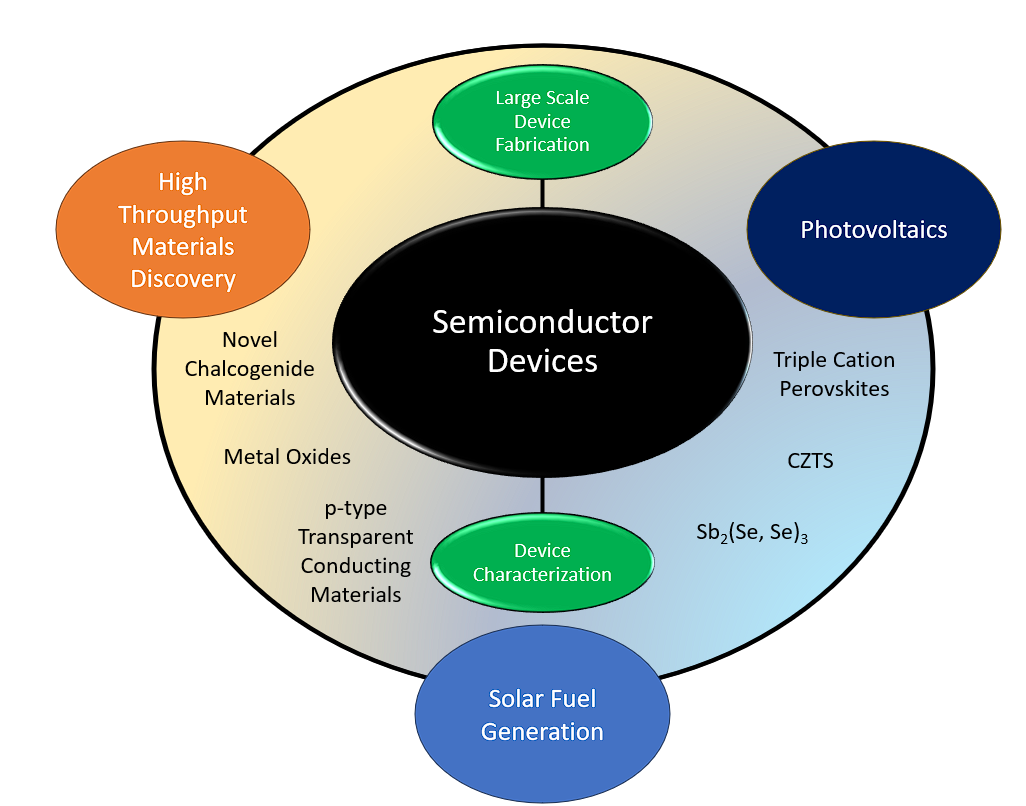Research Topics and Interests

Our research group is interested in utilising semiconductor materials to harvest the abundant solar energy available. With the impending climate crisis, there is a demand for renewable energies to replace fossil fuels in everyday applications, requiring rapid development of efficient solar harvesting materials [1] that can efficiently produce alternatives to fossil fuel based technologies Our research can be broadly split into three major areas: photovoltaics, solar fuel generation, and high throughput materials discovery, where we work on a wide array of materials spanning oxides, chalcogenides and perovskites.

Development of efficient solar cell devices for harvesting solar energy poses a significant challenge due to a range of issues, including and not limited to
defects states, film quality, reproducability, band alignment, stability and cost for production. We hope to control the properties of solar harvesting
materials to create reproducible devices suitable for industrial scale-up and large-area applications, with the aim of cheap, high efficiency, robust
solar cell devices. An example of such a device would be for semi-transparent window applications, where the lifetime and reproducability of these large scale
devices are key to it's everyday use.
Our group thus focuses on three separate classes of materials: perovskite solar cells, Cu2ZnSnS4 (CZTS), and Sb2(S, Se)3. In these materials, we seek to
understand how to control the distribution of intrinsic defects such as antisite defects, grain orientation and grain boundaries to achieve higher efficiency.
Our work thus far has shown capabilities in controlling the properties by doping and substitution of various ions, notably in triple cation perovskites
[2] and substituted CZTS materials
[3] [4]
[5]
where the cation exchange allows for suppression of antisite defects whilst retaining or improving its original properties.
Additionally, strategies in device fabrication, such as substrate choice and thus device architecture and optimising growth processes, have led to
perovskite [6]
and Sb2(S, Se)3 solar cells [7] with increased quality.

There is also interest in clean, green fuel generation as an alternative to renewable energy sources.
Interest in this derives from two aspects: first to allow for carbon sequestration by converting carbon dioxide
into reusable fuels such as carbon monoxide (for syngas), formic acid, methanol and multicarbon products, and secondly to facilitate lower emissions
in sectors which are less easily electrified, such as transport and aviation. Both the carbon dioxide reduction and hydrogen evolution reaction
occur in-tandem with the oxygen evolution reaction. These reactions can be mediated by either electricity from renewable sources (electrochemical) or by utilising
the solar spectrum itself (photoelectrochemical).
Selective, long-lasting catalysts remains as the major barrier to large-scale applications of the carbon dioxide reduction reaction. This is because there
remains a poor understanding in the mechanisms of the carbon dioxide reduction reaction, thus leading to difficulties in catalyst design. In particular, catalysts need
to facilitate sufficient binding of the reactants but have a weaker binding energy with the products of interest, thus allowing only specific products
to be produced (hence high selectivity). Our group is currently interested in several potential catalysts, such as bimetallic copper chalcogenides and
single atom catalyststs, where the combination of atoms allow for tuning the binding energies and thus the selectivity and rate of reaction.
Photoelectrochemical water splitting for hydrogen generation also holds much interest as the reaction mechanism is broadly dictated by the band alignment
of the photocathode with the solution. Water splitting only proceeds if the band edge of the photocathode is high enough to overcome the overpotential
necessary for the reaction to proceed, limiting the photocathode choice. This issue is further compounded with possible degradation, whether due to photon
or immersion of the photocathode in water or acidic media. Our group is interested in optimising device composition and structures of CZTS
[8] [9]
and Sb2Se3 photocathodes to allow for efficient capture of the solar spectrum and charge transport to the solution.
The oxygen evolution reaction faces issues shared by both the carbon dioxide reduction and hydrogen evolution reaction, where there is concern in catalyst
discovery to allow for the 4-electron transfer in the oxygen evolution whilst still allowing for efficient charge transport by ensuring the band alignment
of the device is suitable for the reaction mechanism. This is further complicated by potential catalysts-photoanode interaction that may change the energetics
of the reaction [10] . Numerous methodologies have been employed in order to optimise the
photoanode performance [11] .
We currently focus on binary metal oxides for photoanodes and seek to optimise its composition using high throughput screening.

Due to the wide range of atoms available on the periodic table, there remains a concern over the time and resources required for development of efficient
materials. Thus, there is a demand for an automated efficient methodology for screening potential materials and compositions for various applications.
Our group is interested in applying high throughput screening methodologies towards aspects of our research to accelerate discovery of novel materials
to fabricate better devices for photovoltaics and solar fuel generation.
To date, our group has employed high throughput screening in identifying potential dopant species for photoanode materials used in solar fuel generation
[12] .
This topic is of interest as there are a wide range of potential dopants and concentrations that will affect the fermi level and thus band alignments
of the material with the solution, thus influencing the photoanode properties. High throughput screening enabled uniform and rapid identification of
potential materials, providing starting points for future work in optimising the performances of the devices.
Our group is interested in applying high throughput methodologies in other parts of our research. This includes identifying new p-type
transparent conducting materials for n-i-p based photovoltaics, catalysts for solar fuel generation (whether for oxygen evolution, hydrogen generation
or carbon dioxide reduction) and new photoabsorber materials or dopants to facilitate better device performance.